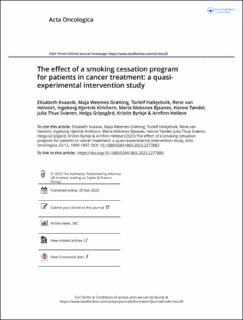| dc.contributor.author | Kvaavik, Elisabeth | |
| dc.contributor.author | Grøtting, Maja Weemes | |
| dc.contributor.author | Halkjelsvik, Torleif | |
| dc.contributor.author | van Helvoirt, Rene | |
| dc.contributor.author | Kirkhorn, Ingeborg Hjertvik | |
| dc.contributor.author | Bjaanes, Maria Moksnes | |
| dc.contributor.author | Tøndel, Hanne | |
| dc.contributor.author | Sværen, Julia Thue | |
| dc.contributor.author | Gripsgård, Helga | |
| dc.contributor.author | Byrkje, Kristin | |
| dc.contributor.author | Helleve, Arnfinn | |
| dc.date.accessioned | 2024-02-05T13:22:00Z | |
| dc.date.available | 2024-02-05T13:22:00Z | |
| dc.date.created | 2023-11-27T10:08:54Z | |
| dc.date.issued | 2023 | |
| dc.identifier.citation | Acta Oncologica. 2023, 62 (12), 1890-1897 | en_US |
| dc.identifier.issn | 0284-186X | |
| dc.identifier.uri | https://hdl.handle.net/11250/3115654 | |
| dc.description.abstract | Background
Compared to non-smokers, smokers have reduced effects of cancer treatment, and increased risk of treatment-related toxicity. Quitting smoking can improve treatment effects and reduce side effects. This study reports on the potential impact of a smoking cessation program on smoking cessation rates among patients in cancer treatment.
Material and methods
Cancer patients 18 years and older who smoked, with survival prognosis ≥12 months, not suffering dementia or other mental illness, and who were referred to cancer treatment at six Norwegian hospitals were invited to participate. The study took place from 2017 to 2020 and used a pre-test-posttest non-equivalent control group design. The intervention group received structured smoking cessation guidance based on Motivational Interviewing combined with cost-free nicotine replacement products, while the control group received standard smoking cessation treatment. Self-reported smoking status were registered at baseline and at 6 months’ follow up.
Results
76% of patients smoked at baseline and 44% at follow-up in the intervention group, correspondingly 72% and 49% in the control group. In an analysis of differences in within-person change, the reduction in the intervention group was 13 percentage points larger (95% CI = (0.25, −0.005), p = 0.041). Adjusting for gender, age, education, labour market participation and partnership status did not attenuate the estimated effect (18 percentage point difference, 95% CI = (−0.346, −0.016), p = 0.032). Demographic factors and dropout rate differed somewhat between the groups with a higher dropout rate in the intervention group, 54% vs. 51%, respectively).
Conclusion
Offering a structured smoking cessation program based on Motivational Interviewing and cost-free nicotine replacement products to cancer patients can increase cessation rates in comparison to standard smoking cessation care. | en_US |
| dc.language.iso | eng | en_US |
| dc.publisher | Taylor & Francis | en_US |
| dc.rights | Navngivelse 4.0 Internasjonal | * |
| dc.rights.uri | http://creativecommons.org/licenses/by/4.0/deed.no | * |
| dc.title | The effect of a smoking cessation program for patients in cancer treatment: a quasi-experimental intervention study | en_US |
| dc.title.alternative | The effect of a smoking cessation program for patients in cancer treatment: a quasi-experimental intervention study | en_US |
| dc.type | Peer reviewed | en_US |
| dc.type | Journal article | en_US |
| dc.description.version | publishedVersion | en_US |
| dc.source.pagenumber | 0 | en_US |
| dc.source.journal | Acta Oncologica | en_US |
| dc.identifier.doi | 10.1080/0284186X.2023.2277883 | |
| dc.identifier.cristin | 2202639 | |
| cristin.ispublished | true | |
| cristin.fulltext | original | |
| cristin.qualitycode | 1 | |

